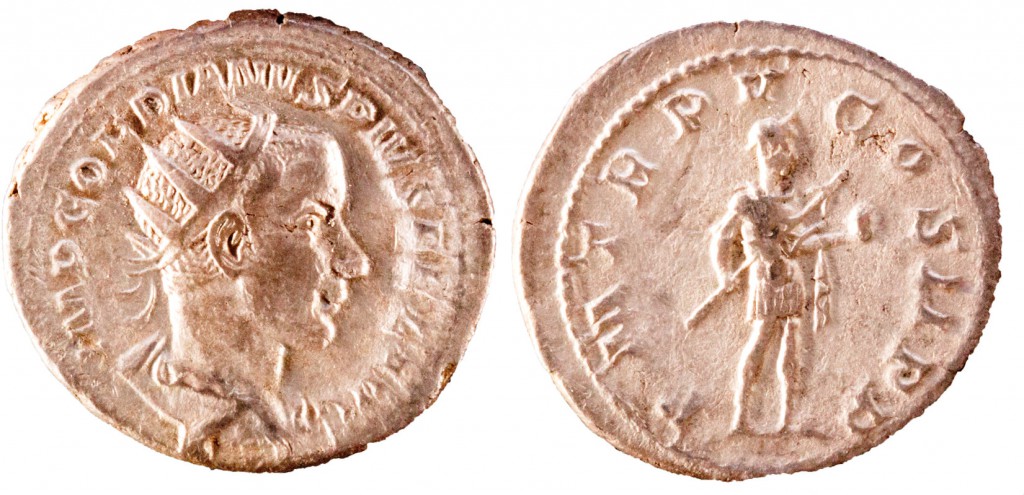February 11, 2015, by Will Leveritt
1771 years ago today: Roman emperor Gordian III died aged just 19
Text by Rob Stone
Images by Kelly Grimshaw
On February 11th 244, the rule of the emperor Gordian III was brought to an end. The circumstances of his death are unclear; the widespread belief within the empire was that his successor, Philip the Arab, had ordered the young emperor to be lynched by his own soldiers. But evidence from the Sassanid Empire suggests that he died in battle with their king, Shapur I.

AR antoninianus of Gordian III. Obverse shows radiate, draped bust of emperor right, IMP GORDIANVS PIVS FEL AVG. Reverse has Gordian standing right in millitary clothing holding spear and globe, P M TR P V COS II PP. 4.28g, 23mm, 12 o’clock.
However, the confusion surrounding Gordian’s death was not the only notable moment of his reign; on the 22nd April 238, Gordian became the youngest emperor to obtain sole control of the Roman Empire aged just 13. The Empire he inherited had been damaged by usurpations following the end of the Severan dynasty; after the death of Severus Alexander in 235, the empire passed into the hands of the unpopular Maximinus I, who ruled for three years before his reign collapsed. In what was to become known as the Year of the Six Emperors, Gordian’s grandfather (Gordian I) and uncle (Gordian II) revolted against Maximinus. Despite the two Gordians being recognised as co-emperors by the Senate and enjoying the support of Rome’s people, they failed to overcome Maximinus’ army and died in North Africa only 20 days after their revolt began. The Senate then turned their support to two patricians, Pupienus and Balbinus, but appointed Gordian III as junior emperor alongside the pair to appease those still loyal to the Gordian family.
With his two partners secure in Rome, Pupienus set out to defeat Maximinus in the field. Yet the two were never to meet in battle; upon his return to Italy, Maximinus lay siege to the town of Aquileia, which had refused to open its gates to the emperor. His soldiers, frustrated by the lack of progress or a conclusive victory, turned on their general and offered his head to Pupienus upon his arrival. The death of Maximinus did not, however, result in the end of the empire’s instability; within two months the rule of the three co-emperors had collapsed due to arguments and mistrust between Pupienus and Balbinus. On July 29th 238, the Praetorian Guard took matters into their own hands and ended the conflict by murdering the quarrelsome Pupienus and Balbinus, leaving the teenage Gordian as sole emperor.
Over the next six years Gordian, with the assistance of his advisors and generals, stabilized the empire by fending off invasions from the Carpi and the Goths, defeating the usurper Sabinianus and bringing in a series of reforms across the empire. The decision to invade the Sassanids in late 242 also initially paid dividends, with Gordian and his armies driving Shapur from Mesopotamia. However, Gordian’s war ended in disaster on the 11th of February when he suddenly died — bringing an end to the Gordian dynasty. Within the Persian Empire, Shapur I declared in his Res Gestae (written in three languages and inscribed on major roads) that Gordian was slain in battle, but this contradicts the Roman accounts that the emperor survived, only to be murdered on the orders of his successor Philip.
The belief that Philip murdered the popular young emperor Gordian would dog the new emperor throughout his five year reign.

Delightfully written article and very informative. If only we knew the absolute truth surrounding his death!